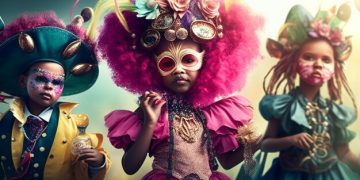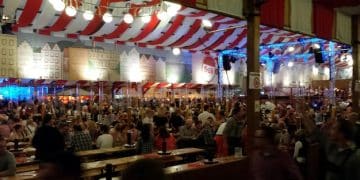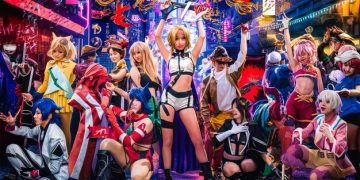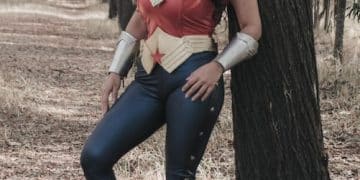The Ultimate Guide to Cosplay: Mastering the Art of Transformation

Cosplay, short for “costume play,” is a performance art where participants create and wear costumes to represent specific characters, often from anime, manga, comic books, video games, and movies, allowing fans to embody their favorite fictional figures.
Dive into the exciting realm of cosplay, where creativity meets craftsmanship and imagination takes form. Whether you’re a seasoned pro or a curious beginner, this guide unlocks the secrets to mastering the art of transforming into your beloved characters.
What is Cosplay? Unveiling the World of Costume Play
Cosplay has grown from a niche hobby to a global phenomenon. But what exactly does it entail, and why is it so captivating? Let’s explore the basics and understand what makes cosplay such a unique and engaging activity.
At its core, cosplay is more than just wearing a costume; it’s about embodying a character and bringing them to life. The dedication and creativity involved in cosplay make it an art form appreciated by geeks and enthusiasts around the world.
The Origins of Cosplay
Cosplay’s roots trace back to the science fiction and fantasy conventions of the early 20th century but gained significant traction in Japan during the 1970s. The term “cosplay” itself was coined in the 1980s, and the hobby quickly spread internationally.
Why People Cosplay
The reasons for participating in cosplay are as diverse as the characters cosplayers portray. For many, it’s a creative outlet, a chance to express their admiration for a particular character or series. For others, it’s about the community and the joy of sharing their passion with like-minded individuals. Cosplay also offers a unique opportunity for self-expression and personal growth.
- Creative Expression: Cosplay allows individuals to showcase their artistic skills through costume design and creation.
- Community Engagement: Cosplaying at conventions and events fosters a sense of belonging and camaraderie.
- Character Embodiment: Cosplayers enjoy embodying their favorite characters, bringing them to life for others to appreciate.
- Personal Growth: The process of creating a costume and performing as a character can boost confidence and develop new skills.
Cosplay is a multifaceted hobby that blends creativity, community, and self-expression. It offers a unique way for fans to engage with the characters and stories they love, making it a vibrant and ever-evolving art form.
Getting Started: Essential Steps for Beginners
Embarking on your first cosplay journey can seem daunting, but with the right guidance, it can be an incredibly rewarding experience. Here are some essential steps to help beginners get started.
The first step is choosing a character that resonates with you. Next, planning and researching your costume is key. Finally, gathering materials and starting the creation process can be started.
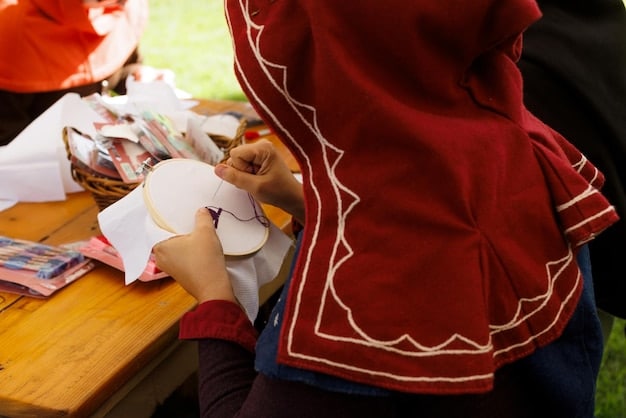
Choosing Your First Character
Select a character you feel a strong connection with and whose costume aligns with your skill level. Starting with simpler designs can help build your confidence and avoid early frustrations. Consider characters with recognizable features but less complex outfits.
Planning and Research
Thorough research is crucial. Gather reference images from various angles to understand the costume’s details. Create a detailed plan, breaking down the costume into manageable components. Knowing what kind of materials you need to gather is key to ensuring positive results.
Gathering Materials and Tools
Create a list of all the necessary materials and tools. This might include fabrics, sewing supplies, foam, paint, wigs, and accessories. Shop around for the best deals and consider borrowing or renting tools if needed.
- Fabric Selection: Choose fabrics that match the texture and appearance of the character’s outfit.
- Tool Kit: Assemble a basic sewing kit, including needles, thread, scissors, and a measuring tape.
- Specialty Items: Depending on the costume, you may need specialized materials like EVA foam for armor or wigs for hairstyles.
Starting your cosplay journey involves careful planning and preparation. Choosing the right character, conducting thorough research, and gathering the necessary materials will set you up for a successful and enjoyable experience. As you progress, you can gradually tackle more complex projects and refine your skills.
Mastering Costume Creation: Techniques and Tips
Creating a cosplay costume involves a variety of techniques, depending on the character’s design. Whether you’re sewing, crafting armor, or styling a wig, there are numerous tips and tricks to help you achieve a professional look.
Sewing is fundamental for creating many costumes. Armor creation often involves working with EVA foam. Finally, wig styling transforms pre-made wigs into character-specific hairstyles.
Sewing Basics
For fabric-based costumes, understanding basic sewing techniques is essential. Learn how to read patterns, operate a sewing machine, and perform essential stitches. Practice on scrap fabric before working on your actual costume to avoid mistakes.
Armor Creation
Many cosplay costumes include armor or prop elements. EVA foam is a popular material for creating lightweight and durable armor pieces. Use templates, heat guns, and craft knives to shape the foam, then seal and paint it for a realistic finish.
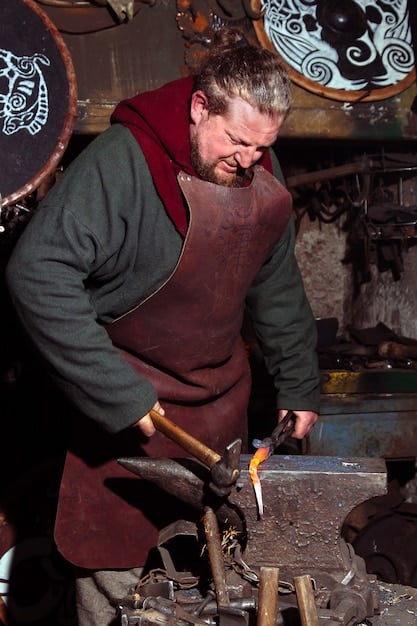
Wig Styling
A well-styled wig can significantly enhance your cosplay. Learn basic wig styling techniques, such as trimming, layering, and spiking. Use heat-resistant wigs if you plan to use styling tools like hair dryers or straighteners. Be sure to choose a wig of high quality to ensure it performs to your liking.
- Pattern Adaptation: Modify existing patterns to fit your specific measurements and the costume’s design.
- Foam Detailing: Add intricate details to foam armor using smaller pieces of foam and carving tools.
- Wig Maintenance: Properly clean and store your wigs to prolong their lifespan and maintain their style.
Mastering costume creation involves a combination of sewing, armor crafting, and wig styling skills. By learning these techniques and practicing regularly, you can create impressive and accurate cosplay costumes. Each skill builds upon the other, enhancing the overall quality and impact of your cosplays.
Accessorizing Your Cosplay: Props and Details
No cosplay is complete without the right accessories. Props, weapons, and other details can elevate your costume and make your portrayal more authentic. Here are some tips for creating and incorporating these essential elements.
Selecting the right props is essential for enhancing the visual impact. Crafting realistic weapons adds a level of authenticity to your character. Additional details, such as makeup and jewelry, are the finishing touches that complete the look.
Choosing the Right Props
Consider the character’s signature items and choose props that are true to their design. Research the materials and construction methods used in the original source material for an accurate representation. Attention to detail makes all props much better than props poorly made.
Weapon Crafting
Crafting weapons requires careful planning and execution. Use lightweight materials like PVC pipes, foam, and cardboard to create safe and manageable props. Apply realistic paint and weathering techniques to achieve an authentic look.
Adding the Final Touches
Makeup can transform your appearance to match your character’s features. Use high-quality products and practice your application techniques. Jewelry and other small details can also enhance your costume’s authenticity.
- Prop Safety: Ensure that all props are safe to carry and pose with at conventions and events.
- Weathering Techniques: Use paints, washes, and dry brushing to create a worn and realistic look on your props.
- Makeup Tutorials: Watch tutorials and practice applying makeup to achieve the desired character effect.
Accessorizing your cosplay involves selecting the right props, crafting realistic weapons, and adding the final touches with makeup and jewelry. By paying attention to these details, you can create a more immersive and convincing portrayal of your chosen character. Each accessory contributes to the overall impact of your cosplay, showcasing your dedication and craftsmanship.
Cosplay Photography: Capturing Your Creation
Once you’ve created your cosplay, capturing it through photography is a great way to share your work and celebrate your achievements. Whether you’re shooting at a convention or in a studio, here are some tips for getting the best photos.
Finding the right photographer is crucial for capturing the essence of your cosplay. Posing techniques can enhance your photos. Finally, editing and post-processing polish your images.
Finding a Photographer
Look for photographers who specialize in cosplay photography. Review their portfolios and discuss your vision for the shoot. A collaborative approach can help you achieve stunning results.
Posing and Expression
Practice different poses and expressions that match your character’s personality. Study reference images and experiment with different angles. Confidence is key to capturing memorable photos.
Editing and Post-Processing
Post-processing can enhance your photos by adjusting colors, lighting, and details. Use editing software to refine your images and achieve a professional look. Keep the edits subtle to maintain the authenticity of your cosplay.
- Location Scouting: Choose locations that complement your costume and enhance the overall aesthetic.
- Lighting Techniques: Use natural and artificial lighting to create depth and highlight details.
- Photo Release: Ensure that you have permission to use the photos for your portfolio and social media.
Cosplay photography is essential for capturing your creation and sharing it with the world. By finding the right photographer, mastering posing techniques, and using editing software effectively, you can create stunning images that showcase your cosplay in the best possible light. Each photo becomes a testament to your hard work and creativity.
Cosplay and Community: Conventions and Events
Cosplay extends beyond individual creations; it’s also about community and connection. Conventions and events provide opportunities to showcase your costumes, meet other cosplayers, and celebrate your shared passion. Here’s what you need to know about participating in these gatherings.
Attending conventions provides opportunities to showcase your work. Engaging with the community enriches the cosplay experience. Finally, following etiquette ensures respectful interactions within the community.
Attending Conventions
Cosplay conventions are vibrant gatherings where cosplayers can display their creations, participate in contests, and attend panels and workshops. Plan your attendance in advance, and be sure to review the convention’s rules and guidelines.
Engaging with the Community
Conventions and online forums provide opportunities to connect with other cosplayers. Share your work, offer support, and collaborate on projects. Building relationships can enhance your cosplay experience and provide valuable learning opportunities.
Cosplay Etiquette
Respectful behavior is essential in the cosplay community. Always ask for permission before taking photos of other cosplayers. Be mindful of personal space and cultural sensitivities. Promote a positive and inclusive environment.
- Convention Prep: Pack essentials like repair kits, comfortable shoes, and plenty of water.
- Social Media: Use hashtags to share your cosplay photos and connect with other enthusiasts online.
- Inclusivity: Welcome newcomers and promote diversity within the cosplay community.
Cosplay thrives on community engagement, and conventions and events are central to this aspect. By attending conventions, engaging with fellow cosplayers, and following proper etiquette, you can enhance your skills, expand your network, and contribute to a vibrant and inclusive community. Each interaction adds to the shared joy and creativity that defines cosplay.
| Key Point | Brief Description |
|---|---|
| 🎭 Understanding Cosplay | Cosplay involves embodying characters through costumes and performance. |
| 🛠️ Costume Creation | Skills include sewing, armor crafting, and wig styling for accurate designs. |
| 📸 Cosplay Photography | Capturing your cosplay through quality photos involves finding the right photographer and practicing posing. |
| 🤝 Community Engagement | Conventions and online forums foster connections and learning within the cosplay community. |
FAQ
▼
Cosplay is short for “costume play,” a performance art where participants wear costumes and accessories to represent a specific character. It is especially popular within the geek community.
▼
Select a character you love and whose costume matches your skill level. Start with simpler designs to build confidence. Then, as you improve, consider more challenging outfits.
▼
EVA foam is a popular choice for armor due to its lightweight nature and durability. It can be easily shaped and painted to achieve a realistic look. Many professional cosplayers swear by it.
▼
Practice posing and choose locations that match your character’s world. Collaborate with a photographer who understands cosplay. After you get the pictures, make sure to edit them lightly.
▼
Bring a repair kit for costume malfunctions, comfortable shoes, water, and snacks. Also, bring your convention ticket. Finally, research the convention map layout.
Conclusion
In conclusion, cosplay is a rewarding and multifaceted hobby that combines creativity, craftsmanship, and community. Whether you’re a beginner or an experienced cosplayer, there’s always something new to learn and explore in this vibrant world. Embrace your passion, express your creativity, and connect with others who share your love for cosplay.
